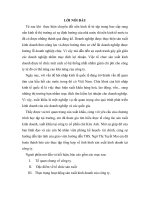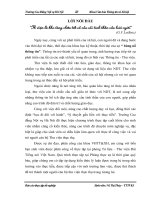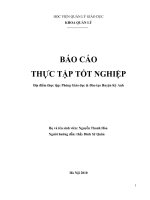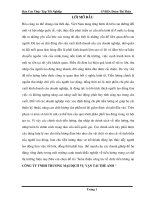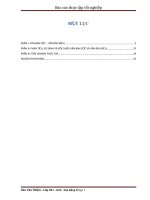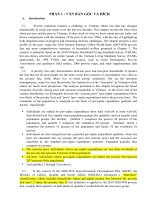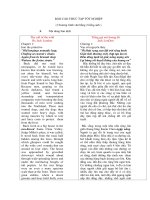Báo cáo thực tập tốt nghiệp tiếng anh (4)
Bạn đang xem bản rút gọn của tài liệu. Xem và tải ngay bản đầy đủ của tài liệu tại đây (276.88 KB, 54 trang )
VINH UNIVERSITY
FOREIGN LANGUEAGE DEPARTMENT
********************
AN INVESTIGATION INTO ERRORS OF USING
THE PRESENT PERFECT TENSE BY SECONDARY
SCHOOLS STUDENTS
(điều tra lỗi khi sử Dụng thì hiện tại hoàn thành
của học sinh trung học phổ th«ng)
GRADUATION THESIS
Field: linguistics
Supervisor : Vũ Thị Việt Hương, M.A
Student
Class
:
: Phạm Thị Huyền
45E2 – English
Vinh, 2009
ACKNOWLEDGEMENTS
I have received great assistance from many people in the
preparation of this thesis. With out their assistance and support,
this thesis might not have been finished.
Firstly, I would like to express my special words of thanks to
M.A Vò Thị Việt Hương, my supervisor for the supporting to fulfill
my thesis. She has given me precious advices valuable materials
and greatly essential corrections for accomplishment of this
thesis.
Secondly, I should also like to extend my deep thanks to all
my teachers in the Department of Foreign language, who did their
best in helping me to finish the course as well as this thesis.
I repeat my thanks to the students who have participated in
classes reported in this thesis as well as teachers of Hermann
Gmeiner high school, if with out their cooperation the research
will be far from perfect.
Finally, I wish to express my sincere thanks to my beloved
family and close friends for their encouragement and support to
my doing this thesis.
Vinh, May 2009
Phạm Thị Huyền
List of abbreviations
V
:
V(pII) :
Verb
Verb past participle
S
:
Subject
O
:
Object
C
:
Complement
Adj
:
Adjective
Use 1
:
Duration of state up to the present moment
Use 2
:
Indefinite past
Use 3
:
Resultative perfect
Use 4
:
Experiential perfect
e.g.
:
For example
i.e.
:
That is to say
etc
:
et cetra
L1
:
The first language
L2
:
The second language
OUP
:
Oxford University Press
TESOL :
*
Teaching English to Speakers of Foreign Language
:
Incorrect sentence
List of diagrams, tables and charts
Diagram 1: Use 1 (Duration of state up to the present moment)
Diagram 2: Use 2 (Indefinite past)
Diagram 3: Use 3 (Resultative perfect)
Diagram 4: Use 4 (Experiential perfect)
Table 1.2.:
Verbs and Particles
Table 2.1:
Results of section 1
Table 2.2:
Results of section 2
Table 2.3:
Results of section 3
Table 3.1:
Total number of errors and their causes in three
sections
Table 3.2:
Total errors in four uses of three sections
Table 3.3.1.3: A comparison of the four uses of the present perfect
tense
Chart 2.1:
Results of section 1
Chart 2.2:
Results of section 2
Chart 2.3:
Results of section 3
Pie chart 3.2: Total errors in four uses of three sections
TABLE OF CONTENTS
Page
ACKNOWLEDGEMENT……………………………………………………..i
LIST
OF
ABBREVIATIONS………………………………………………….ii
LIST
OF
DIAGRAMS,
TABLES
AND
CHARTS…………………………...iii
TABLE OF CONTENTS………………………………………………………
iv
ABSTRACT…………………………………………………………………….vii
i
PART
I:
INTRODUCTION………………………………………………...1
1.1.
Rational
of
the
of
the
of
the
study……………………………………………….2
1.2.
Aims
study……………………………………………………2
1.3.
Scope
study…………………………………………………...2
1.4.
Method
of
the
of
the
study…………………………………………………2
1.5.
Design
study……………………………………………….....2
PART
II:
CONTENTS……………………………………………………..4
CHAPTER
I:
THEORITICAL
BACKGROUND…………………………….4
1.1.
Tense
and
Aspect
in
Tense
in
Aspect
in
English………………………………………..4
1.1.1.
English…………………………………………………….4
1.1.2.
English……………………………………………………6
1.1.3.
Time
reference……………………………………………………....7
1.1.4.
The
present
perfect
tense
in
English………………………………...8
1.1.4.1.
Duration of state up to the present (USE 1)
………………………...11
1.1.4.2.
Indefinite
past
(USE
2)
……………………………………………..12
1.1.4.3.
Resultative
past
(USE
3)
(USE
4)
Aspect
in
……………………………………………13
1.1.4.4.
Experiential
perfect
………………………………………..14
1.2.
Tense
Vietnamese…………………………………...14
and
1.3.
Errors
in
language
learning
process………………………………...18
1.3.1.
The
notion
of
errors…………………………………………………18
1.3.2.
Errors
and
mistakes…………………………………………………19
1.3.3.
Error
analysis………………………………………………………..20
1.3.4.
Causes of errors in second language
learning……………………….20
1.3.4.1.
Interlingual
errors
…………………………………………………..20
1.3.4.2.
Intralingual
errors…………………………………………………...21
1.3.4.2.1.
Overgeneralization……………………………………………
…….22
1.3.4.2.2. Ignorance
of
rule
restrictions……………………………………….22
1.3.4.2.3. Incomplete
application
of
rules……………………………………..23
1.3.4.2.4.
False
concepts
hypothesized………………………………………...23
CHAPTER
II:
THE
STUDY………………………………………………….24
2.1
Research
questions………………………………………………….
2.2.
setting……………………………………………………..24
Research
2.3.
Instrumentation……………………………………………………...24
2.3.1.
Justification
for
the
uses
of
the
tests………………………………...24
2.3.1.1.
The
grammar
test……………………………………………………26
2.3.1.2.
The
Vietnamese-English
translation
test……………………………27
2.3.1.3.
The
syntax
completion
test………………………………………….27
2.3.2.
The
test
process……………………………………………………...27
2.4.
Investigated
procedure………………………………………………27
2.5.
Preliminary
results
and
data
analysis………………………………..28
2.5.1.
Results
of
section
1
–
Grammar
test………………………………...28
2.5.2.
Results of section 2 – Translation
test………………………………29
2.5.3.
Results of section 3 – Syntax completion
test……………………….30
2.6.
Errors
and
their
causes………………………………………………32
2.6.1.
Errors and their causes in section
1…………………………………32
2.6.2.
Errors and their causes in section
2…………………………………35
2.6.3.
Errors and their causes in section
3…………………………………38
CHAPTER
III:
FINDING
AND
DISCUSSION………………………………..41
3.1.
Major
findings……………………………………………………… 41
3.2.
Comparing the number of errors in four uses of the
present
perfect
tense………………………………………………………………………………
43
3.3.
Implications for teaching and learning the present perfect
tense
in
English…………………………………………………………………………….
43
3.3.1.
Suggestions for teaching the present perfect tense in
English………44
3.3.1.1.
Teaching
meaning
based
on
and
L2
context………………………………...45
3.3.1.2.
A
comparison
of
L1
grammar……………………………….45
3.3.1.3.
Teaching each use with different duration of
time…………………. 46
3.3.2.
Suggestions for learning the present perfect
tense…………………..47
3.4.
Suggestions
for
further
research……………………………………..47
PART
CONCLUSION………………………………………………….48
III:
REFERENCES
APPENDIX
Abstract
This thesis is an investigation into the use of the present
perfect tense by second language learners at secondary school
with the following aims: (1) To find out the errors made by
students in using of the present perfect tense and their causes:
(2) To provide some suggestions for teaching and learning the
present perfect tense effectively.
The main methods that are applied to this thesis are the
survey, analysis, and comparison methods. The instruments in
this thesis are three different tests designed in a written form to
collect the students’ errors in using the present perfect tense
effectively. The errors considered in this thesis are mainly focused
on interlingual errors and intralingual errors. Then, the data
collected from the tests are analyzed to find out the causes.
After investigating the uses of the present perfect tense by
the corpus consisting of three tests, it has been found out that the
second language learners at secondary school often meet
difficulties in understanding and using this tense. They often
commit errors in using the present perfect tense. From the major
findings of the study, there are some possible suggestions, which
would be given for learning and teaching English at secondary
school. There is a hope that they will play an important role to
improve second language knowledge for Vietnamese learners and
teachers of English as well as for all those who are concerned
about teaching and learning the present perfect tense.
Part I:
Introduction
1.1. Rationale of the study
English is the language of international communication. In
recent years there are more and more people considering about
the need of English learning. In order to improve the quality of
English learning and teaching many great efforts have been
made. These include the search for and implication of new and
more effective teaching methods. Special attention has also been
paid to research in different areas of the teaching and learning
English. In the processes of learning, however, learners cannot
avoid errors. As Spada and Lightbown (2002, p.167) stated that:
“Errors are natural part of language learning. The errors reveal
the patterns of learners’ developing interlanguage systems –
showing where they have over generalized a second language
rule or where they have inappropriately transferred the first
language rule into the second language ’’ .
For second language learners in general and for second
language students at secondary school in particular, or even
others who have acquired a high level of English proficiency still
make errors in their production of the second language. We can
see clearly the evidences of these errors in different parts. For
example: In syntax, Vietnamese learners made errors in following
areas: wrong use or omission of prepositions and articles as in the
following example sentence (In the left bank of Huong river *),
wrong use of word order in the sentence (She very much needs to
meet them *). Alternatively, wrong form of verbs in tenses is also
a difficulty as (He goes to school yesterday *).
In learning English grammar, especially the learning tenses,
there are many difficulties and errors for Vietnamese learners of
English as well as students at Hermann Gmeiner high school, Vinh
City where the investigation has been carried out. Although they
have been taught and understood the rules of grammar clearly,
they cannot avoid errors and some kinds of errors even become
habitual. These errors can be seen in both learning process at
school and the results of the exams at the end of each term.
Therefore, it is necessary to carry out an investigation into the
use of tenses, especially into the use of the present perfect tense
to study errors, which made by students to identify their causes
and find out the solutions to help improving the effects of
teaching and learning English.
For the reasons as above, the writer has decided to choose
the topic “An investigation into errors of the use of the present
perfect tense by second language learners at secondary school’’.
1.2. Aims of the study
The study reported in this thesis aims to
a. Identify errors in using the present perfect
tense faced by Vietnamese learners at high school
b. Find the major causes and sources of the errors
committed by high school students in using the present perfect
tense, and
c. Make some suggestions for teaching and
learning this tense.
1.3. Scope of the study
English grammar is a complex field for both learners and
researchers. Due to limit time and research condition, this study
does not aim at covering all problems or difficulties met by
students in learning English grammar. This thesis will focus on
investigating students’ errors in the acquisition of English
particular grammatical case: The uses of one English syntactic
structure named the present perfect tense, which is often used
incorrectly by Vietnamese students.
1.4. Method of the study
This study uses methods:
- Investigating and analyzing method
- Explanation method
- Comparison method
- Synthesis method
1.5. Design of the study
There are three parts in this research paper
Part I: Introduction
This part deals with: The rationale, aims, scope, methods,
and design of the study.
Part II: Content
This part consists of three chapters:
Chapter I: Theoretical background
This chapter will provide an in-depth review of the relevant
literature related to the issue under investigation. Especially, a
review of the uses of the present perfect tense in English will
provide the theoretical framework for the identification of the
errors that students made. In addition, theories about the sources
of errors will help explore what factors caused students’
commitment of errors in using the present perfect tense. Error
analysis as the main theoretical tool for analyzing data will also
be reviewed.
Chapter II: The study
This chapter will present the methodology adopted to
collect data for the research, which includes the description of
research questions, setting, instrumentations, data collection
techniques. This chapter will also present and discuss the results
and findings of the study.
Chapter III: Findings and discussion
This part will summarize major finding, suggest some
implications for teaching and learning the present perfect tense in
English.
Suggestions for further researcher will also be presented.
Part III: Conclusion
In this part, it is summarized. Some implications for
teaching, suggestions for learning the present perfect tense are
given, and suggestions for further research are presented.
The appendixes and references are placed at the end of the study.
PART II:
CONTENT
Chapter I: Theoretical background
1.1. Tense and aspect in English
There are various traditional school grammarians as well
as linguists paying attentions to English tense and English aspect
category. They considered the category as a complex study.
According to Geoffrey Leech who identified verb tense and verb
aspect as “two of the most troublesome areas of English’’ (Jacobs,
1985, p.187). With the aims at helping learners to understanding
further this field, the thesis would like to introduce some general
points of view about this.
1.1.1.
Tense in English
According to Quirk et, al (p.40) “Time is a universal, non-
linguistic concept with three divisions: past, present, future’’
The diagram of time
Past
present
future
Diagram 1.1.1. The diagram of time
In English Syntax, Jacobs (p.187) believe that “Aristotle
who is said to have been the first to recognize the category of
tense’’. He also observed, “there were systematic variations in
the form of Greek verbs, variations that could be correlated with
time notions such as past and present’’ .This lead to some
different definitions of other linguists. For example, Quirk et, al,
(2003, p. 40) defined tense as “the correspondence between the
form of the verb and our concept of time’’. Jacobs, (1995, p.187)
defined that “tense is the grammatical marking on verbs that
usually indicates time at which some other situation was in
force’’. It refers to absolute location of an event or action in time,
either speaking point or others. It is remarked by inflections such
as “s /es’’, “d / ed’’ or other past participle verbs.
For example:
It snows in Alaska
(1)
present tense
It snowed in Alaska, yesterday
past tense
(Azar, 2004, p. 3)
(2)
The first sentence is the present tense when the action
(event) which is happened in time of speaking and marked by an
inflection “s”. However, the first sentence’s tense will be in past
tense if the narrative sentence’s action (event) is happened in
past time, and now it is retold. The verb will be marked by an
inflection “d / ed ’’. The second sentence is in the past tense
because time reference is in the past “yesterday” and verb is
marked by an inflection “ed”.
The tense system involves distinctions of time reference, and
is grammaticalized to give only two tenses: past and present.
Studying English tense, Jacobs also mentioned that there is “a
two-tense system” in English, which is past tense and present
tense.
Present tense: Time reference of action can be in the past
time, in time of speaking, even in future time. The grammatical
markings are inflection “s”, “es”
For example:
Lady Godiva rides on a snow- white house
(Jacobs, 1995, p.190)
Past tense: Time reference of the action has to be in the
past time, recent moment. The grammatical markings are the
inflections “ed”, “d”, and different forms of verb past.
For example:
Yeltsin greeted the new ambassador
(Jacobs, 1995, p. 196)
In a short word, tense in the concept in the grammatical
category that involves on verb form and time reference when the
action (event) which happened either in time or not in time. Tense
is released by an inflection of the verb, so that we easily find that,
there are two tenses in English, as the linguists’ saying “is twotense systems”
1.1.2.
Aspect in English
What is aspect? Answering this question, these some
linguists who provided definitions of aspect as follows: “Aspect is
the general name given to verb forms used to signify certain ways
in which an event is viewed experienced”
(Jacobs, 1995,
p. 199)
On discussing aspect, Quirk et, al defined as” the manner in
which verbal action is experienced or regarded”. (p.40)
For example:
Jane Austen was writing her greatest novel
Maureen Duffy has now written a novel about
two friends.
(Jacobs
, p. 201)
The first sentence’s tense is the past tense, it refers to a
time in the past and the writing act was continuing at the time
referred to. Tense is marked by form of verb “be”, and aspect is
progressive aspect because the effect of verb “be” on the main
verb showed the ongoingness of the situation at that time. Hence,
the sentence’s tense is the past tense, its aspect is the
progressive aspect.
The second sentence’s tense is present tense. Although the
action takes place in the past and is completed, time reference is
now. Because the action is shown to take place quite recently and
still suit to the time of speaking. The use of perfective auxiliary
“have / has” with the main verb in past participle form which
follows “has” to show the aspect. Thus, the sentence’s tense is
the present tense and its aspect is the perfective aspect.
Form of aspect:
Progressive aspect:
Be + Ving
Perfective aspect:
Have / has + V
(PII)
These are grammatical markings mark aspect in English.
The lexical meaning of verb can also convey aspectual meaning.
For example, when a verb signifies a temporary state or
continuing activities tend to be a progressive aspect. When a verb
signifies pre-existing states and indicates completed actions tend
to be the perfective aspect.
For example:
I’m writing an essay.
He has just changed his style
In conclusion, aspect is a “complicated phenomenon”.
Linguists have presented two aspects in English including
progressive
and
perfective
aspect
basing
on
grammatical
category and meaning of verb. As Quirk et, al said that the aspect
concerns the verbal ongoing actions on verbal complicated
actions.
1.1.3.
Time reference
Thomson and Martinet: “English uses its two tenses as part
of a complex system for marking time reference”.
(A practical English Grammar.
P.166.OUP)
The tense is used as past tense, the speaker is referring to a
time in the past, but still relates to now. The time reference
relates to now.
For example:
The murderer will have been arrested when he
arrives next week.
(Jacobs,
1995, p. 194)
The action “arrest” will have been occurred in a prior of time
when the murderer comes, the time is not to now.
The time reference is when she arrives on next week. It is related
to some times after now.
To sum up, time reference is “time relative to some fixed
reference point” (i.e. the reference point can be the time of
speaking “now” or can be some other time such as “past”,
“future”).The complexity of the relationships between tense and
aspect as well as tense and time reference has raised some
difficulties for both studiers and learners. The combination among
tense, aspect and time reference have constructed a system of
“compound tense” which lead to confuse to learners.
1.1.4.
The present perfect tense in English
The present perfect tense is the present tense – perfect
aspect combination with different time references. “The present
perfect tense has perfect aspect which means that it is used to
refer to a subject’s past action or states while keeping the subject
in a present state of reference or in a present state of mind”.
( />_perfect tense)
Leech’s opinion shows that the present perfect tense
means, “Past – time – related – to – present – time”. (Leech, G.
1987, p.35)
Other ones defined that the present perfect tense is a
perfect tense used to express action that has been completed
with
respects
the
present.
It is formed by an auxiliary “have / has” embedded a past
participle form of verb.
S + have / has + V (PII)
For example:
I have gone to school
The use of the present perfect tense has been presented by
different points of view of linguists as follows:
In the book Understanding and using English Grammar has
given three uses of the present perfect tense.
(1)The present perfect tense expresses the idea that
something happened or never happened.
For example:
I have never seen snow
(2) The present perfect tense expresses the repetition of an
activity before now. The exact time of each repetition is not
important.
For example:
I have flown on an airplane many times
(3) The present perfect tense used with “for” and “since”
expresses situation that began in the past and continues to the
present.
For example:
I have had the same pair of shoes for three years
(Azar, 2004, p.30)
The three uses of Azar have been mentioned that the events
occurred at some unspecified times in the past, but the events
suit or experience still exists at the present. The situation of
events began in the past and still goes on to the present or even
continuing to the future.
Thomson and Martinet in A Practical English Grammar have
introduced the present perfect tense in five items of the use as
follows:
(1)The present perfect tense with “just” for recently
completed actions.
For example:
I have just gone out
(2) The present perfect tense used for past actions whose
time is not definite. It expresses the recent actions when the time
is not mentioned; Recent actions in the present perfect often have
results in the present; and can also used for action which occur
further back in the past, provided the connection with the present
is still maintained, that is that the actions could be repeated in
the present.
For example:
A new bridge has been built across the river
(3) The present perfect tense used for actions occurring in an
uncompleted
prior. It implies that the actions happened or did
not happen at some undefined time during this period. An
uncompleted period may be indicated by today, this morning, this
day, lately, recently, since, for, ever.
For example:
About one hundred buildings and houses have
been destroyed in the earthquake recently.
(4) The present perfect tense used for an action, which lasts
throughout an uncompleted period: The action began in the past
and continues to the time of speaking at the present, however,
some time the action finished at the time of speaking. Time
expressions can be indicated by since, for, all the time, always, all
day.
For example:
It has been rained all day
(5) The present perfect tense used with “for” and “since”
For example:
She has lived in Hanoi for 5 years
The present perfect is a short of mixture of present and past.
It always implies a strong connection with the present and is
chiefly used in conversations, letters, newspapers, and television
and radio reports.
Studying about “functions of the present tense – perfect
aspect combination” (Other calling is the present perfect tense),
Jacobs has given four major functions (usage) as follows:
(1) Past indefinite usage: The present perfect tense refers to
recent events enough to be new and relevant to the present,
thereby connecting the present to these past events. This
function some times called the “hot news” usage. The time of the
events is happened always left unspecified.
(2) The state usage: The present perfect is used with perfect
aspect, which can be used to report the existence of the stable
state of affairs over a continuous period of time up to the present.
(3) The change of state usage: (Resultative perfect) perfect
aspect refers to a present state as the result of a past event.
(4) The current usage: Perfect aspect is used with predicates
that refer to actions that are habitual or can be repeated more
than once.
(Jacobs, 1995,
p. 201-203)
A part from the above-mentioned uses, there are many
linguists have written about this including: Liz and John Soars (the
Student
book
–
Headway),
Raymond
Murphy
(the
English
Grammar in Use), Michael Swan (the Practical English Usage),
Leech (the Meaning and the English Verb), etc.
Every English grammarians has presented this category, from
their points of view researcher have found that the Use of Leech
in
Meaning
and
the
English
Verb
has
provided
a
clear
understanding the present perfect tense. The uses are the
summary of other linguists’ points of view. They are: (1) Duration
of state up to the present moment; (2) Indefinite past; (3)
Resultative perfect; (4) Experiential perfect.
The first uses are the same to those of Azar, Thomas –
Matinet, and Jacobs. The next use is the same to the classification
of Jacobs and Swan. The last is similar to that of Swan and John
and Lizsoar. These uses will be described in details as the
following parts.
1.1.4.1. Duration of state up to the present moment (USE
I)
The present perfect is used to express an action or state,
which extends over a period lasting up to the present moment of
speaking or writing. It may continue to the future. We will use an
adverbial of duration as “since” or “for” to express it. “Since” is
used for a point of time in the past, and “for” is used for duration
of time (period of time)
For example:
I have not seen him since November
I have used my left hand for a month now
(Thomson and Martinet, p.
168-169)
This use is considered the typical one of the present perfect
tense. The linguists have used the use to show the relationship
from past time to the present time.
